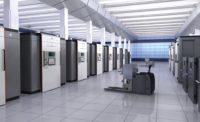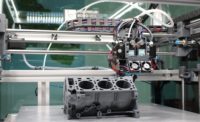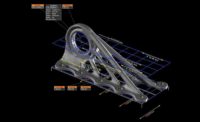Quality and production performance play a crucial role in automotive manufacturing today. With many automotive innovations on the horizon, such as autonomous vehicles and smart cars, OEMs and suppliers are under pressure to adopt new manufacturing techniques and expertise to ensure design, cost and labor efficiencies.
One simple, yet critical application in automotive quality and production ripe for transformation is the use of manufacturing aids, like jigs, fixtures, templates and gages. These often-overlooked tools help manufacturers deliver products reliably, repeatedly and at a low cost in order to maximize profits and product quality. Using additive manufacturing (or 3D printing) to produce jigs and fixtures not only can reduce lead times, it can provide significant cost savings through reduced material consumption and improved design.
This article covers the benefits of 3D printing jigs and fixtures over traditional fabrication methods, as well as the limitations of additive manufacturing, ideal applications for additive manufacturing on the production floor and case studies from two automotive manufacturers that are 3D printing jigs and fixtures today.
Benefits of 3D printing jigs and fixtures
Traditionally, manufacturers have CNC machined or molded jigs and fixtures, requiring a high investment with uncertain returns. Additive manufacturing has the ability to quickly produce new parts in lightweight and inexpensive materials and to provide significant cost savings, reduced material consumption and improved performance. And 3D printing jigs and fixtures offers the following key advantages:
Speed to market – With 3D printing you can bring new production lines online faster because jigs and fixtures can be 3D printed on demand. Lead times are 40-90% faster than conventional fabrication.
Design freedom – 3D printing builds parts from the ground up, layer by layer, which removes traditional design-for-manufacturing constraints and opens up endless opportunities for tool configuration. Holes, contours and complex organic structures are no longer an obstacle when designing for additive manufacturing.
Component consolidation – Tools previously built with multiple components requiring their own assembly time can be redesigned and combined into one part due to 3D printing’s design freedom.
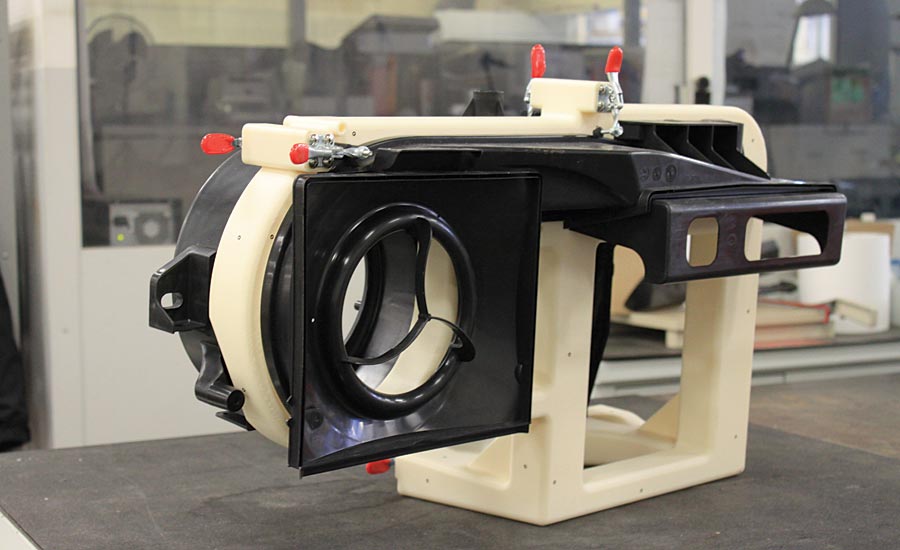
3D printed check fixture to verify HVAC assembly’s design, accuracy and stability.
Ergonomics – The additional design freedom also allows you to create curves and contours to help increase worker comfort and ergonomics. With no added cost or fabrication time, you can design for functionality rather than manufacturability to increase safety and comfort for employees who use and interact with tools.
Weight reduction – Another comfort and safety advantage for production floor employees is weight reduction. There are many strong, lightweight plastics available for 3D printing vs. cumbersome and heavy machined metals.
Digital inventory – 3D printers build directly from CAD data, so new designs can be produced as-needed and existing designs can be modified with ease. For example, if the size of the final part changes requiring a new assembly jig, it’s just a matter of updating the CAD file, ordering a 3D printed part, and a new fixture is on the production floor within a matter of days.
All of these benefits lessen risk and put more manufacturing aids on the production floor for better accuracy and consistent operational performance.
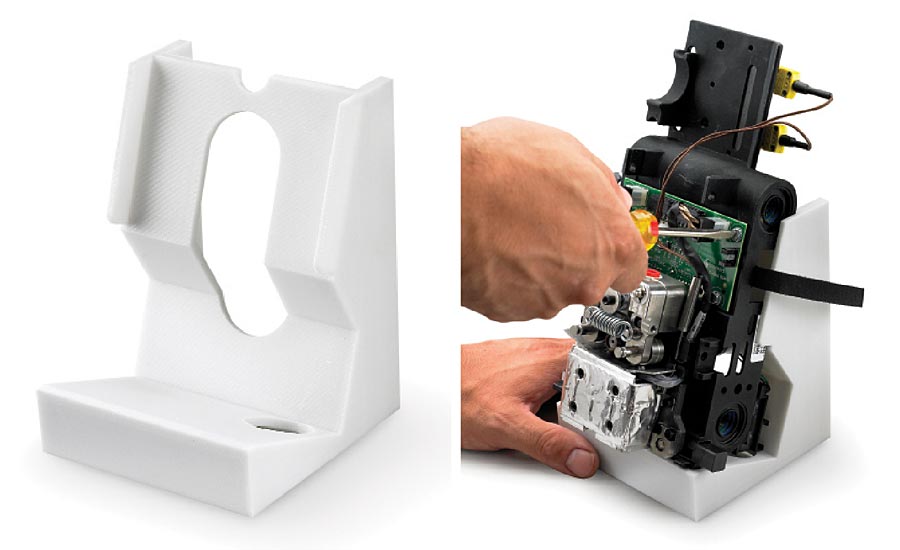
3D printed electronics assembly fixture.
Additive manufacturing on the production floor
While the terms “jigs” and “fixtures” are often used together, they have distinct differences and are used in differing applications. Jigs are customized tools used to guide and control the location and motion of a component during an operation. They provide repeatability and accuracy to maximize efficiency when manufacturing products. Fixtures, on the other hand, are devices used to locate and hold a component in a fixed location during a machining operation or another industrial process. Fixtures maintain consistent quality, reduce the cost of production and enable a variety of parts to be made to correct specifications.
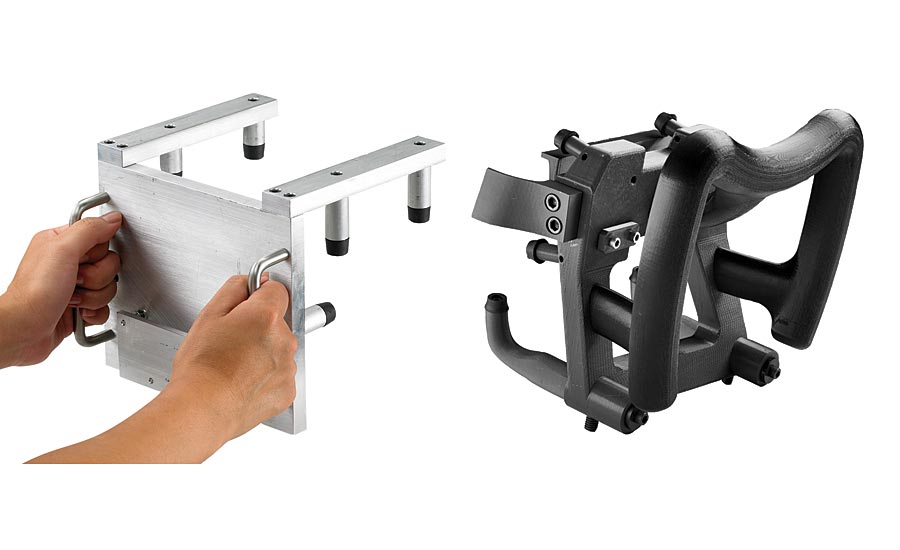
BMW used additive manufacturing to build lighter fixtures with design complexities.
From assembly and quality control to logistics, jigs and fixtures streamline operations to manufacture a range of automotive parts. Common applications for 3D printing jigs and fixtures in the automotive industry include:
Production & assembly – 3D printed tools are most commonly implemented in this stage of manufacturing for alignment and holding devices, and guides for milling or drilling components, either attached to equipment or used by workers.
Safety – Often workers are involved in checking the safety of components and equipment, so it’s important for jigs and fixtures to be lightweight and ergonomic for easier use.
QC & inspection – 3D printing delivers highly-accurate, customized tools that meet stringent specifications for holding or inspecting devices in quality and inspection departments. Durable thermoplastics formulated for additive manufacturing can also provide a non-marring surface for final inspection.
Packaging & logistics – The most common application in packaging and logistics is building customized holding fixtures for the transportation of products throughout the factory. Additive manufacturing offers durable, heat-resistant thermoplastics that can withstand transportation stresses, such as vibration, pressure and humidity.
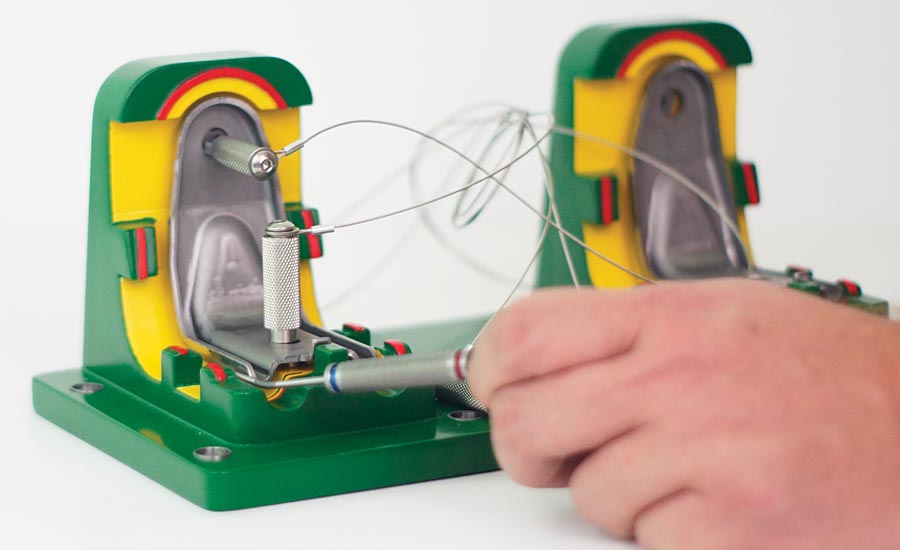
An automotive seat manufacturer shaved 31% in costs and 90% in weight with a 3D printed check fixture.
Limitations of using additive manufacturing for jigs and fixtures
Despite the many opportunities and advantages of 3D printed jigs and fixtures there are some limitations to consider when choosing additive over conventional fabrication. Some manufacturing environments and processes require high heat-deflection temperature (HDT). Although there are additive manufacturing technologies that offer HDT materials, such as fused deposition modeling (FDM) and laser sintering (LS), some environments may exceed their mechanical properties. There also may be mechanical stress requirements that exceed the capabilities or mechanical properties of additive materials. While additive manufacturing technologies offer a wide range of materials, there are always instances in which polymers formulated for 3D printing will not meet the mechanical or chemical resistance requirements. Lastly, there may be high quantities or very simple geometries that could be easier and more cost-effective to produce using conventional manufacturing methods.
It’s an exciting and disruptive time in the automotive industry. Manufacturers who innovate beyond vehicle design, and transform each area of the design and production process will gain a competitive edge. Additively manufactured jigs and fixtures will continue to be a key element to that success by improving worker productivity, eliminating errors, and increasing lead times for inspection and delivery. Q
Automotive manufacturers improving quality with 3D printed fixtures
Many automotive manufacturers and suppliers are maintaining efficient production with complex and custom 3D printed manufacturing aids. Here are two examples of automotive suppliers using additive manufacturing to streamline their production floors.
TS Tech
TS Tech Co., Ltd. is the world’s sixth-largest interior component manufacturer with assembly plants in 13 countries across the globe and is the number one seat supplier for an international automotive company. Stephen Mollett, a tooling engineer who oversees the fixtures and tools used to inspect seat frames, needed to improve the solid aluminum check fixture used to inspect a back-seat hinge. Using the check fixture, workers visually, aesthetically and mechanically validate hole placement and depth, part width, dimension and form. Employees were often required to carry the original 40-pound fixtures by hand or with a cart across the facility.
Mollett worked with Stratasys Direct Manufacturing to redesign and 3D print a new fixture that not only addresses weight, but also incorporates new functionality. The 3D printed tool is one-tenth of the weight of the original aluminum fixture at four pounds. It also used half the metal and was produced in just two weeks, while the original aluminum fixtures took six weeks or more to manufacture. This rapid turnaround time means TS Tech can keep pace with the frequent design changes of their seating systems. It also costs significantly less—resulting in 31% direct cost savings.
The project has increased the priority of using 3D printing applications to address other tooling needs on the factory floor. “It’s opened the floodgates for 3D printed jigs and fixtures at TS Tech,” says Mollet.
MAHLE
MAHLE, a global automotive parts supplier, needed a check fixture to verify an HVAC assembly’s design, accuracy and stability. The fixture had to be designed, built and shipped from the U.S. to South Korea within a week. Given the timeline and internal 3D printing knowledge and technology gaps, the team turned to Stratasys Direct Manufacturing to help design and build the fixtures. Stratasys Direct and MAHLE worked together to redesign the original part for additive manufacturability and consolidate multiple components into one. Stratasys Direct used the fused deposition modeling (FDM) 3D printing process and ASA, a production-grade thermoplastic with UV stability. In less than a week, MAHLE had a redesigned dimensionally-accurate and stable part shipped across the world—a process that would have taken four to five weeks with conventional manufacturing.
“Moving 3D printing forward within the company has been my primary motivation in doing this project,” says Joe Czach, prototype shop manager at MAHLE. “In the last few weeks, our eyes have been opened in terms of what can be done with it.”

